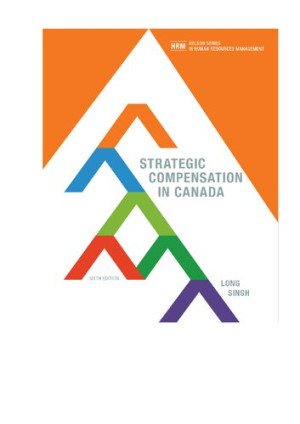Specifications
| book-author | Richard Long ; Parbudyal Singh |
|---|---|
| file-type | |
| isbn10 | 0176657169 |
| isbn13 | 9780176657161 |
| language | English |
| publisher | Nelson Education |
Book Description
“Strategic Compensation in Canada, 6th Edition” by Richard Long and Parbudyal Singh provides a comprehensive overview of compensation management practices tailored specifically for the Canadian context. Here's an overview of what you can expect from this edition:
- Introduction to Compensation Management: The book begins with an introduction to the fundamental concepts and principles of compensation management. It explores the strategic importance of compensation in attracting, motivating, and retaining employees, as well as its impact on organizational performance and competitiveness.
- Legal and Regulatory Framework: Long and Singh discuss the legal and regulatory framework governing compensation practices in Canada. They cover relevant legislation, regulations, and employment standards related to compensation, ensuring compliance with Canadian labor laws and regulations.
- Strategic Compensation Planning: The text emphasizes the strategic aspect of compensation planning, highlighting the need for aligning compensation strategies with organizational objectives and business goals. It explores various approaches to compensation strategy development, including market-based, job-based, and competency-based approaches.
- Job Analysis and Evaluation: Long and Singh delve into the process of job analysis and evaluation, which forms the foundation of compensation management. They discuss methods for assessing the relative value of jobs within an organization, including job ranking, job classification, and point-factor systems.
- Pay Structures and Administration: The book covers the design and administration of pay structures, including base pay, variable pay, and benefits. It explores different pay structures such as salary ranges, pay grades, and pay-for-performance systems, as well as issues related to pay equity and pay compression.
- Employee Benefits and Perquisites: Long and Singh examine the role of employee benefits and perquisites in total compensation packages. They discuss various types of employee benefits, including health insurance, retirement plans, paid time off, and other fringe benefits, as well as the strategic implications of benefit design and administration.
- Compensation Communication and Total Rewards: The text addresses the importance of effective communication about compensation programs and total rewards to employees. It explores strategies for transparent and equitable communication, as well as the role of total rewards statements in enhancing employee understanding and appreciation of their compensation packages.
- Performance Management and Incentive Compensation: Long and Singh discuss the linkages between performance management and incentive compensation. They explore the design and implementation of incentive compensation programs, including individual and group-based incentives, profit sharing, and stock options, as well as the role of performance appraisal in driving performance-based pay decisions.
- Compensation Challenges and Emerging Trends: The book concludes with a discussion of current challenges and emerging trends in compensation management, such as pay equity, diversity and inclusion, flexible work arrangements, and the impact of technology on compensation practices. It examines how organizations are adapting to these trends and evolving their compensation strategies accordingly.
Overall, “Strategic Compensation in Canada, 6th Edition” serves as a comprehensive resource for students, HR professionals, and business leaders seeking to understand and implement effective compensation management practices in the Canadian context. It combines theoretical insights with practical guidance and real-world examples to provide a holistic view of compensation management in today's dynamic and evolving workplace.













Reviews
There are no reviews yet.